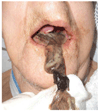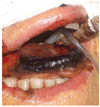Ischemic necrosis of the tongue in patients with cardiogenic shock
- PMID: 20564667
- PMCID: PMC3001120
- DOI: 10.1002/lary.20974
Ischemic necrosis of the tongue in patients with cardiogenic shock
Abstract
Objectives/hypothesis: Ischemic necrosis of the tongue is a rare entity generally associated with vasculitis. Critically ill patients with shock might experience hypoperfusion of head and neck end organs including the tongue.
Study design: Retrospective analysis of hospital charts.
Methods: Case histories and photographs of five patients who developed ischemic tongue necrosis in the context of cardiogenic shock.
Results: Five critically ill patients in our institution's cardiothoracic intensive care unit developed ischemic necrosis of the tongue. All five patients experienced protracted courses of profound cardiogenic shock requiring high-dose vasopressor support and urgent cardiac surgery. Three patients required intra-aortic balloon pumps. All patients had concomitant signs of poor end organ perfusion, including lower extremity ischemia and renal and hepatic failure. Ultimately, four of five patients died, with one patient surviving after sloughing of the entire oral tongue.
Conclusions: Ischemic necrosis of the oral tongue is an uncommon but perhaps under-reported manifestation of end organ hypoperfusion in shock, likely signifying poor prognosis.
Conflict of interest statement
The authors have no funding, financial relationships, or conflicts of interest to disclose.
Figures




References
-
- Missen GAK. Gangrene of the tongue. Br Med J. 1961;1:1393–1394.
-
- Sofferman RA. Lingual infarction in cranial arteritis. JAMA. 1980;243:2422–2423. - PubMed
-
- Ginzburg E, Evans WE, Smith W. Lingual infarction: a review of the literature. Ann Vasc Surg. 1992;6:450–452. - PubMed
-
- McRorie ER, Chalmers J, Campbell IW. Lingual infarction in cranial arteritis. Br J Clin Pract. 1994;48:280. - PubMed
MeSH terms
Grants and funding
LinkOut - more resources
Full Text Sources

